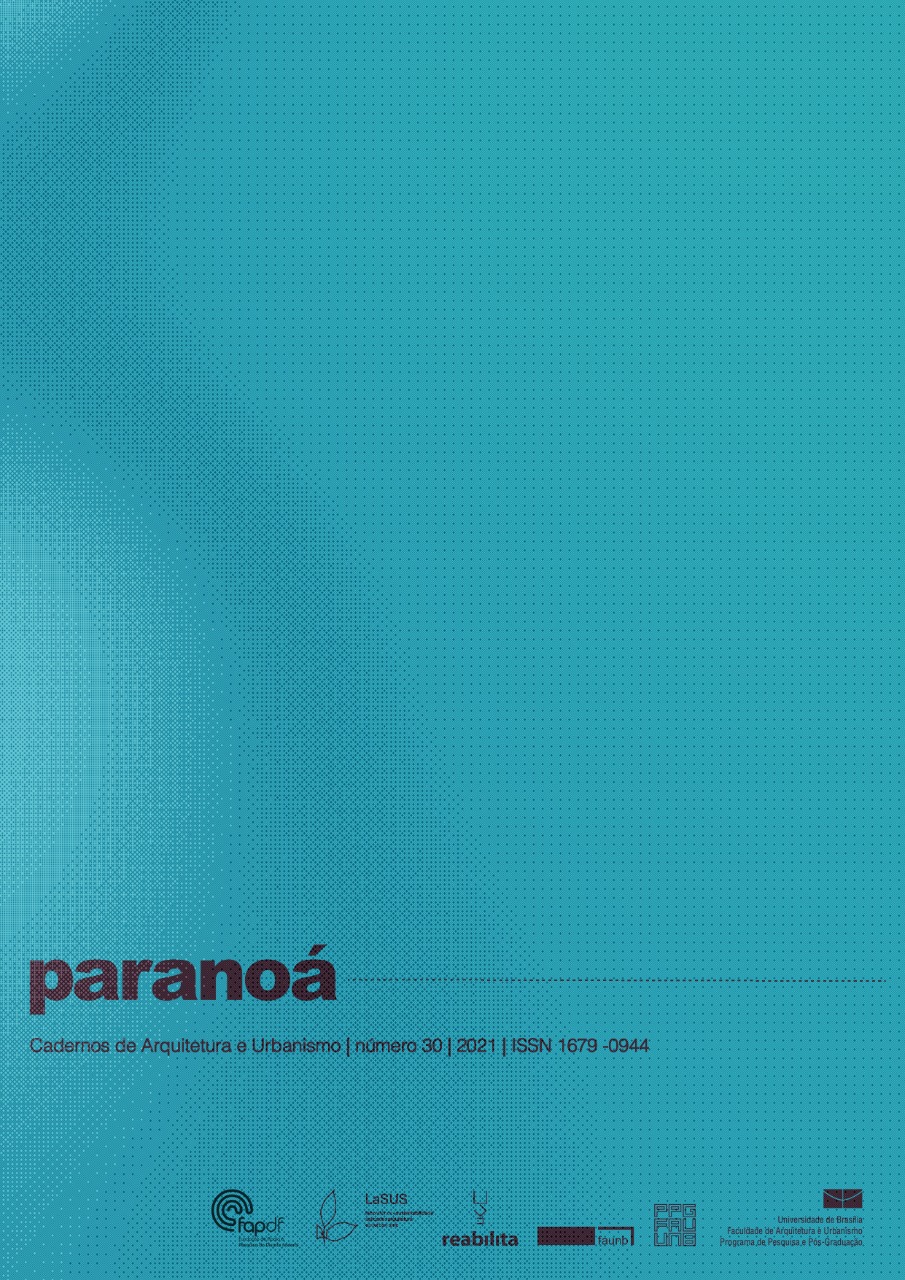Urban micro-climates in Panama city:
study of three historical clippings of urban occupation
DOI:
https://doi.org/10.18830/issn.1679-0944.n30.2021.03Keywords:
Panamá city; Urban materials; Urban geometry; Urban Heat Island (UHI); Local Climate Zones (LCZs)Abstract
Some variables of the climate that influence the hygrothermal comfort of the urban space, which is influenced by the characteristics of its urban geometry (urban landscape) and its natural environment (natural landscape). This work analyzes the qualities of urban space using the Local Climate Zones (LCZs) in three different areas of Panama City. The study is based on the construction of a model for simulation of the urban microclimate using Envimet v.4.4.5 - Science software, and is carried out in 4 stages: i) data collection, ii) modeling, iii) simulation, iv) Data extraction. The work showed that the classification system of LCZs, of Stewart and Oke (2012) allows a better understanding of the behaviors of different urban microclimates. In addition, it was found that the use of arborization in the built space is vital to mitigate the high temperatures of the surfaces, be they pavements or floors covered with grass. The three cuts did not show much difference between them in temperatures (28.6, 28.18, 28.7 °C) and relative humidity (61.92, 62.94, 62.62 %); but it was evident that the Vista Hermosa neighborhood had a ZCL with UHI characteristics, indicating the highest minimum (28.24°C) and maximum (28.7°C) night temperature of the three cuts analyzed.
Downloads
References
ACP. Autoridad del Canal de Panamá. Construcción del Canal Francés. Obtenido en https://micanaldepanama.com/historia-del-canal/la-construccion-del-canal-frances/. Acceso en Junio/2020.
BRUSE, M. Environmental Modelling and Software, ENVImet v.4.4.5 -Science. 2020.
GARTLAND, L. Ilhas de Calor: Cómo mitigar zonas de calor em áreas urbanas. Ed.Oficina de Textos. São Paulo. 2010.
GOOGLE MAPS. Mapas de Ciudad de Panamá. Obtenido en https://www.google.com/maps/place/Panam%C3%A1/@8.3768031,-82.3504484,7z/. Acceso junio 2020
HIDROMET. Hidrometereología/ETESA. El Clima de Panamá. 2007. Obtenido en: http://www.hidromet.com.pa/clima_panama.php. Acceso en mayo/2020.
________Mapa de Clima según clasificación Köppen. 2007. Obtenido en http://www.hidromet.com.pa/Mapas/Mapa_Clasificacion_Climatica_KOPPEN_2007_Panama.pdf. Acceso en junio/2020.
HIGUERAS, Esther. Urbanismo Bioclimático. Gustavo Gili. Barcelona. España. 2017.
INEC- Instituto Nacional de Estadística y Censo. Censo de Panamá. Obtenido en: https:/www.inec.gob.pa/archivos/P6691Distribuci%C3%B3n%20Territorial%20y%20MIgraci%C3%B3n%20Interna%20en%20Panam%C3%A1-Censo2010_F.pdf. 2014. Acceso en Junio/2020.
KOENIGSBERGER, O.; INGERSOL, T.; MAYHEW, A.; SZOKOLAY, S. Viviendas y Edificios en zonas cálidas y tropicales. Ed. Paraninfo. Madrid . España. 1977.
LABAKI, L et al. Vegetação e Conforto térmico em Espaços Urbanos Abertos. Forum Patrimônio. Belo Horizonte. v. 4, n. 1, p. 23-42. 2011.
MASCARÓ, Lucia. Ambiência Urbana. 1° Edição. Ed Zagra d Luzzato. Porto Alegre. Brasil. 1996.
MASCARÓ, L.; MASCARÓ J. Vegetação Urbana. 4° Edição. Ed. Maisquatro. Porto Alegre. 2015.
OLGYAY, Víctor. Arquitectura y Clima. Manual de diseño bioclimatico para arquitectos y urbanistas. 14° edición. Edición em Español. Editora Gustavo Gili. España. 1998.
ONU ODS 2030. La Agenda 2030 y los Objetivos de Desarrollo Sostenible. Meta 11: Ciudades y Comunidades Sostenibles. 2018. Disponible en: https://www.un.org/sustainabledevelopment/es/cities/. Acceso en junio 2020.
OKE, T. R. Initial guidance to obtain representative meteorological observations at urban sites. IOM Rep. 81, WMO/TD-No. 1250, 47 pp. 2004. Disponible en https> www.wmo.int/pages/prog/www/IMOP/publications/IOM-81/IOM-81-UrbanMetObs.pdf.]. Acceso en junio/2020.
ROMERO, Marta Bustos. Princípios Bioclimáticos para o Desenho Urbano. Editora UNB. Brasilia. Brasil. 2013.
________Arquitetura Bioclimática do Espaço Público. Editora UNB. Brasília. Brasil. 2015.
________Arquitetura do lugar. Uma Visão Bioclimática da Sustentabilidade em Brasília. 1° Edição. Ed. Nova Técnica. São Paulo. 2011.
ROMERO, Marta B.; BATISTA, Gustavo; LIMA, Erondina; WERNECK, Daniela; VIANNA, Elen; SALES, Gustavo. Mudanças climáticas e ilhas de calor urbanas. Universidade de Brasília. FAU. 2019. Obtenido en https://repositorio.unb.br/handle/10482/34661?mode=full. Acceso en junio/2020.
SHINZATO, P.; DUARTE, D. H. S. Impacto da vegetação nos microclimas urbanos e no conforto térmico em espaços abertos em função das interações solo-vegetação-atmosfera. Ambiente Construído, Porto Alegre, v. 18, n. 2, p. 197- 215, abr./jun. 2018.
SOLARGIS - Data calculated from GOES satellite data (© 2020 NOAA) and from atmospheric data (© 2020 ECMWF, NOAA and NASA) by Solargis method. Hourly time series (01/01/1999 - 31/01/2020).
STEWART, I.D; OKE, T. R. Local Climate Zones for Urban Temperature Studies.
American Metereological Society. May/2012. Obtenido en https://journals.ametsoc.org/bams/article/93/12/1879/60280/Local-Climate-Zones-for-Urban-Temperature-Studies. Acceso en junio/2020.
WIKIPEDIA. Mapa del Distrito de Panama. Obtenido en https://es.wikipedia.org/wiki/Distrito_de_Panam%C3%A1. Acceso en junio/2020.
URIBE, A. La Ciudad Fragmentada. Ed. Cela. Texas .1989.
Downloads
Published
How to Cite
Issue
Section
License
Copyright (c) 2021 Paranoá: journal of Architecture and Urbanism

This work is licensed under a Creative Commons Attribution 4.0 International License.
Autores que publicam nesta revista concordam com os seguintes termos:
- Autores mantém os direitos autorais e concedem à revista o direito de primeira publicação, com o trabalho simultaneamente licenciado sob a Licença Creative Commons Attribution que permite o compartilhamento do trabalho com reconhecimento da autoria e publicação inicial nesta revista. http://creativecommons.org/licenses/by/4.0
- Autores têm autorização para assumir contratos adicionais separadamente, para distribuição não-exclusiva da versão do trabalho publicada nesta revista (ex.: publicar em repositório institucional ou como capítulo de livro), com reconhecimento de autoria e publicação inicial nesta revista.
- Autores têm permissão e são estimulados a publicar e distribuir seu trabalho online (ex.: em repositórios institucionais ou na sua página pessoal) a qualquer ponto antes ou durante o processo editorial, já que isso pode gerar alterações produtivas, bem como aumentar o impacto e a citação do trabalho publicado (Veja O Efeito do Acesso Livre).















